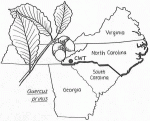Coweeta Hydrologic Laboratory is a 2185-hectare experimental forest located in the Southern Appalachians. It is administered by USDA Forest Service and has been a site for research in forest hydrology since its establishment in 1933. In 1968 scientists at the University of Georgia (UGA) joined with USFS scientists to begin studies of nutrient cycling on the watersheds. Coweeta was an International Biosphere Program site from 1969 to 1974 and became an LTER site in 1982. Current collaborators are from the USFS, UGA and Virginia Polytechnic Institute. There are numerous research opportunities at Coweeta with its 32 gauged watersheds (17 currently active) including 13 where different management prescriptions have been applied.
The focus of LTER research at Coweeta is on disturbance, its impact on terrestrial and aquatic ecosystems and their patterns of recovery. Topics currently being investigated include impacts of a regional drought, long- term recovery from logging, changing patterns of atmospheric deposition, and geomorphic regulation of stream processes.
Impact of a Severe Drought
The single major event during the past five years at Coweeta was the 1986 to 1988 drought, which had an impact on phenomena in all core research areas. This drought was the most severe in the 55-year Coweeta record, with a recurrence interval ranging from 90 to 250 years depending on the dataset used. Severe mortality occurred in pines (Pinus rigida) and oaks (especially Quercus coccinea), which were attacked by the root pathogen Armillaria. Currently, the long-term effects of this episodic event on the structure and processes of forests in the Coweeta Basin are being investigated.
Terrestrial/Aquatic Ecosystems
Watershed 7 was clear-cut by cable logging in 1977, and study of the recovery process of both forest and stream ecosystems is continuing. Terrestrial components examined include: meteorology, vegetation (species succession, NPP, nutrient uptake, physiological changes), decomposition (wood, roots and leaf litter), biogeochernistry (streamwater and internal solute fluxes), forest floor biota, and canopy insets and herbivory. Recovery of the following aspects of the stream ecosystem are also being studied: hydrology, seston transport, organic matter dynamics, and consumer communities.
Atmospheric Deposition
Over the 20-year record of precipitation chemistry at Coweeta, no significant trends in sulfate or H+ are apparent, but nitrate concentrations have increased and total cations have declined. In stream water, sulfate concentrations are increasing and cations and silicates are decreasing; in high elevation streams p1-I is also decreasing. Hence streams appear to be in the initial stages of acidification in the Coweeta Basin. The impact of this on stream processes is part of the LTER studies.
Regulation of Stream Processes
Several ongoing studies are examining the influence of local geomorphology on structural and functional characteristics of stream ecosystems. In one long-term experiment changes have been documented in macroinvertebrate functional group structure and nutrient and organic matter retention when stream geomorphology is altered by debris dams. Additional studies are examining the effect of local geomorphology on retention of nutrients and on abundances and functional group composition of macroinvertebrates at Coweeta.
Intersite Research
Coweeta scientists are involved in numerous intersite research projects including: a comparison of the impact of a regional drought (with North Inlet), research on sulfur dynamics (with Luuillo, North Inlet, and nonLTER sites), wood breakdown and movement in streams (with Luquillo and Andrews), solute transport in streams (with Andrews, Luquillo, Hubbard Brook, Konza, and nonLTER sites), as well as several efforts initiated by scientists at other sites.
For additional information contact Judy Meyer, Institute of Ecology, University of Georgia, Athens GA 30602, or Wayne Swank, Coweeta Hydrologic Laboratory, 999 Coweeta Lab Road, Otto NC 28763.

 Enlarge this image
Enlarge this image